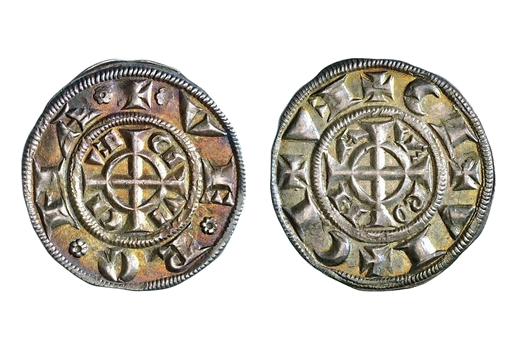
about ancient nomos
Ancient Nomos Art is a museum of galleries exhibiting ancient coins and ancient mint maps. The coin gallery displays the diverse art and history of hand-crafted ancient Greek, Roman, Byzantine, Persian and Medieval coinage. The ancient mints mapping gallery features Greek, Roman, Byzantine, Asia Minor and Medieval mint city regions and territories. Visitor's are welcome to explore, study and enjoy Ancient Nomos Art.

Medieval, Verona – 1250 AD
Verona Grosso
From Ancient Galleries

Obverse: ✿+✿VE✿RO✿NA (rosette stops), cross pattée over large annulet; inner legend, CI VI CI VI in outer voids.
Reverse: +CI+VI+CI+VI, cross pattée over large annulet; inner legend, VE RO N A (retrograde E) in outer voids.
LEGEND
Obv: Outer legend, ✿ + ✿ V E ✿ R O ✿ N A (rosette stops), cross pattée over large annulet; inner legend, CI VI CI VI in outer voids. Rev: Outer legend, + C I + V I + C I + V I, cross pattée over large annulet; inner legend, VE RO N A (retrograde E) in outer voids.
Medieval Verona was one of dozens of 12th and 13th century northern Italian city-based political regimes which had their own governments, military organization and judicial administration and which ruled the city and its wider region (known as contado). Simultaneously, the development of new silver mines in the Italian Alpine region, monetary changes in Byzantium and the Venetian monetary reforms were important factors presented in a wider monetary system influencing each other during this age of the commercial revolution. Venice and Verona began the epoch-making innovation coinage known as the grosso, a coin just over two grams of nearly pure (98.5%) silver, which, according to Stahl, was the first high denomination coin of Latin Europe in five centuries. These issued of Verona grosso were struck under Period of Frederick II as emperor, 1218-1250 AD (Ezzelino da Romano dominus Veronae, 1250-59 AD). Interestingly, hidden within the inner obverse legend and the otter reverse legend is a reference to Frederick II as emperor. Cleverly, the legends both contain four letters in the retrograde form of the abbreviation “FRIR” that, when one reads them correctly, should be interpreted as FR (idericus) I (mperato) R; the abbreviated monogram-like motto referring to Frederick II, emperor and the concessionary of the coinage license for Verona.
DOCUMENTATION
Value: Grosso of 20 denari, piccoli veronesi. Metal: AR Silver. Weight: 1.62 grams. Mint: Republic of Verona. Date: circa 1250-1259 AD.
Attribution: MIR 310; CNI VI 34; Biaggi 2971; De Wit 3609.
Legend, Documentation and Attribution
